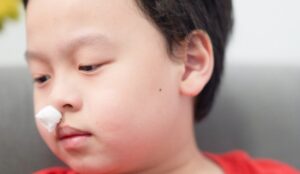Tonsil removal surgery, or tonsillectomy, is a common and effective procedure for children dealing with recurrent tonsil infections or breathing problems caused by enlarged tonsils. While the surgery is routine, recovery can be challenging. This guide will help parents navigate their child’s recovery, manage pain effectively, and ensure optimal healing.
What to Expect After Tonsillectomy
Tonsillectomy is typically performed under general anesthesia as an outpatient procedure, and recovery requires careful attention. Parents should expect a sore throat lasting up to two weeks, mild bleeding in saliva or nasal discharge during the first few days, and fatigue as the body heals. A reduced appetite is also common due to pain while swallowing, but maintaining hydration is essential for a smooth recovery.
Pain Management Tips
Managing pain properly is important for a comfortable recovery. Give pain relievers like Tylenol as directed by the doctor, and avoid aspirin or similar medications unless approved. Placing an ice pack on the neck can help with swelling and discomfort. Eating cold foods like popsicles, ice cream, and chilled soups can also soothe the throat and keep your child hydrated.
Hydration: A Key to Recovery
Keeping your child hydrated is essential for healing and preventing dehydration. Offer cool or room-temperature water, as it is gentle on the throat. Electrolyte drinks like Pedialyte can help maintain fluid balance, while ice chips and popsicles provide a soothing and enjoyable way to stay hydrated. It's best to avoid acidic drinks like orange juice and soda, as they can cause throat irritation.
Best Foods to Aid Recovery
During recovery, soft and cool foods like yogurt, applesauce, mashed potatoes, smoothies, and warm broths are ideal for soothing the throat and ensuring easy swallowing. It's best to avoid crunchy snacks like chips and pretzels, as well as spicy or acidic foods, which can cause discomfort and irritation.
Encouraging Rest and Gradual Activity
Encourage your child to rest for the first 3–5 days after surgery and avoid vigorous activities or exercise for at least two weeks. As they start to feel better, they can gradually return to their normal routine, following the doctor’s advice.
Signs That Need Medical Attention
Monitor your child for potential complications, such as excessive bleeding, indicated by bright red blood or clots, which requires immediate medical care. A high fever, particularly if temperatures exceed 102°F (39°C), should be reported to your doctor. Watch for signs of dehydration, like dry mouth, dark urine, or infrequent urination, and seek medical advice if these occur. Additionally, if your child experiences breathing difficulties, contact a healthcare provider right away.
Key Takeaways
Tonsil removal recovery can be challenging, but with proper care, most children recover smoothly within two weeks. Focus on pain management, hydration, and rest to promote healing. If you notice unusual symptoms, consult your doctor promptly.
Every child’s recovery is unique, and your pediatrician is the best source for advice tailored to your child’s needs.













